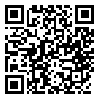Download citation:
BibTeX | RIS | EndNote | Medlars | ProCite | Reference Manager | RefWorks
Send citation to:



BibTeX | RIS | EndNote | Medlars | ProCite | Reference Manager | RefWorks
Send citation to:
Shahraki M, Khazaei A H, Azadi A, Amirpour Haradasht S. Evaluation of predisposing factors for dry socket following extraction of maxillary and mandibular molars: incidence, significance level of variables and comparison of two jaws. J Dent Med-tums 2023; 36 : 13
URL: http://jdm.tums.ac.ir/article-1-6206-en.html
URL: http://jdm.tums.ac.ir/article-1-6206-en.html
1- Assistant Professor, Department of Oral and Maxillofacial Surgery, School of Dentistry, Zahedan University of Medical Sciences, Zahedan, Iran
2- Dental Student, School of Dentistry, Zahedan University of Medical Sciences, Zahedan, Iran
3- Oral and Maxillofacial Surgeon, School of Dentistry, Shiraz University of Medical Sciences, Shiraz, Iran
4- Post-Graduate Student, Department of Oral and Maxillofacial Surgery, School of Dentistry, Zahedan University of Medical Sciences, Zahedan, Iran
2- Dental Student, School of Dentistry, Zahedan University of Medical Sciences, Zahedan, Iran
3- Oral and Maxillofacial Surgeon, School of Dentistry, Shiraz University of Medical Sciences, Shiraz, Iran
4- Post-Graduate Student, Department of Oral and Maxillofacial Surgery, School of Dentistry, Zahedan University of Medical Sciences, Zahedan, Iran
Abstract: (680 Views)
Background and Aims: Dry socket is one of the most common post-tooth-extraction complications. The aim of this study was to investigate the relationship between some of the predisposing factors of dry socket and this complication in all maxillary and mandibular molars and evaluation of its incidence. Furthermore, the two jaws were compared.
Materials and Methods: In this descriptive-analytical cross-sectional study, 150 patients were examined in 2020 in the city of Zahedan. A questionnaire consisting of two sections was designed: In the first section age, gender, systemic disease, smoking status, contraceptive pill consumption, and antibiotic consumption were investigated. In the second section, data related to the difficulty of surgery based on the duration of surgery and the number of local anesthetic cartridges that were administered were collected. Then, the collected data were analyzed by Chi-square and Kruskal-Wallis tests.
Results: The incidence of dry socket was 25.3%. The frequency of dry socket was significantly relevant to smoking, oral contraceptive consumption, difficulty of the surgery, and the number of local anesthetic cartridges that were administered (P≤0.05). Age, gender, controlled systemic disorder, and systemic antibiotic usage for two weeks prior to surgery revealed no significant associations with dry socket (P>0.05). Furthermore, the frequency of dry socket in maxillary and mandibular jaws had a significant difference according to smoking status, difficulty of surgery, and number of local anesthetics carpules (P≤0.05).
Conclusion: It is recommended to identify high-risk groups when performing extraction to consider pre-operative and post-operative measures in order to reduce postoperative complications.
Materials and Methods: In this descriptive-analytical cross-sectional study, 150 patients were examined in 2020 in the city of Zahedan. A questionnaire consisting of two sections was designed: In the first section age, gender, systemic disease, smoking status, contraceptive pill consumption, and antibiotic consumption were investigated. In the second section, data related to the difficulty of surgery based on the duration of surgery and the number of local anesthetic cartridges that were administered were collected. Then, the collected data were analyzed by Chi-square and Kruskal-Wallis tests.
Results: The incidence of dry socket was 25.3%. The frequency of dry socket was significantly relevant to smoking, oral contraceptive consumption, difficulty of the surgery, and the number of local anesthetic cartridges that were administered (P≤0.05). Age, gender, controlled systemic disorder, and systemic antibiotic usage for two weeks prior to surgery revealed no significant associations with dry socket (P>0.05). Furthermore, the frequency of dry socket in maxillary and mandibular jaws had a significant difference according to smoking status, difficulty of surgery, and number of local anesthetics carpules (P≤0.05).
Conclusion: It is recommended to identify high-risk groups when performing extraction to consider pre-operative and post-operative measures in order to reduce postoperative complications.
Article number: 13
Type of Study: Research |
Subject:
Oral and Maxillofacial Surgery
Received: 2023/05/12 | Accepted: 2023/05/31 | Published: 2023/05/31
Received: 2023/05/12 | Accepted: 2023/05/31 | Published: 2023/05/31
Send email to the article author
| Rights and Permissions | |
 |
This work is licensed under a Creative Commons Attribution-NonCommercial 4.0 International License. |




